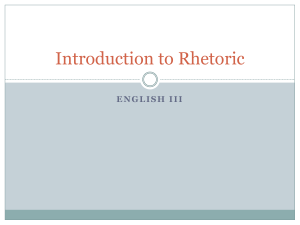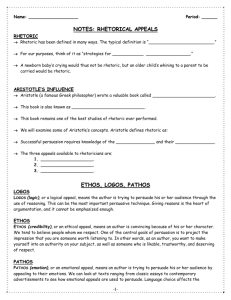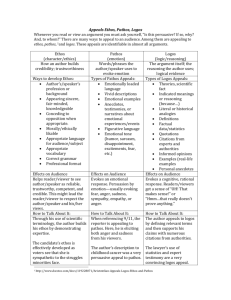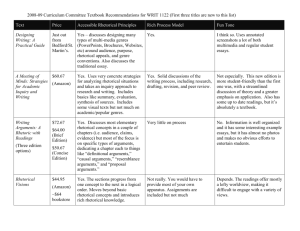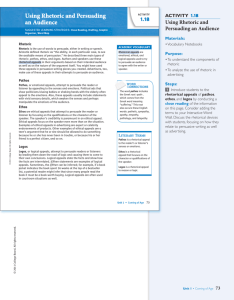Overview of Rhetorical Analysis
advertisement
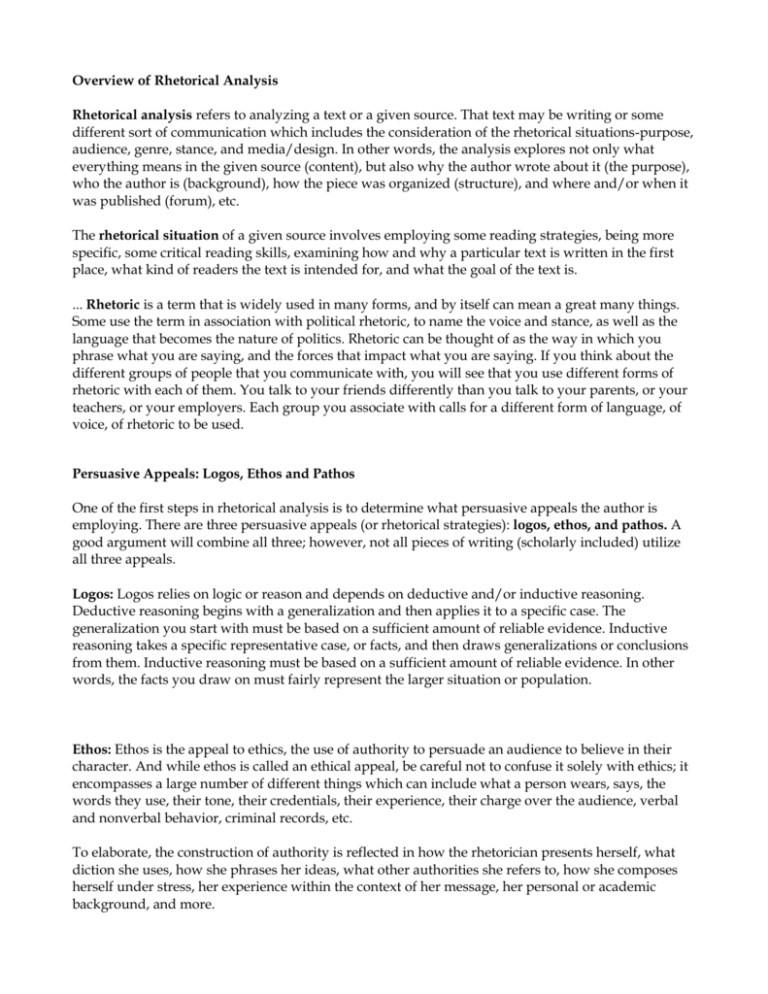
Overview of Rhetorical Analysis Rhetorical analysis refers to analyzing a text or a given source. That text may be writing or some different sort of communication which includes the consideration of the rhetorical situations-purpose, audience, genre, stance, and media/design. In other words, the analysis explores not only what everything means in the given source (content), but also why the author wrote about it (the purpose), who the author is (background), how the piece was organized (structure), and where and/or when it was published (forum), etc. The rhetorical situation of a given source involves employing some reading strategies, being more specific, some critical reading skills, examining how and why a particular text is written in the first place, what kind of readers the text is intended for, and what the goal of the text is. ... Rhetoric is a term that is widely used in many forms, and by itself can mean a great many things. Some use the term in association with political rhetoric, to name the voice and stance, as well as the language that becomes the nature of politics. Rhetoric can be thought of as the way in which you phrase what you are saying, and the forces that impact what you are saying. If you think about the different groups of people that you communicate with, you will see that you use different forms of rhetoric with each of them. You talk to your friends differently than you talk to your parents, or your teachers, or your employers. Each group you associate with calls for a different form of language, of voice, of rhetoric to be used. Persuasive Appeals: Logos, Ethos and Pathos One of the first steps in rhetorical analysis is to determine what persuasive appeals the author is employing. There are three persuasive appeals (or rhetorical strategies): logos, ethos, and pathos. A good argument will combine all three; however, not all pieces of writing (scholarly included) utilize all three appeals. Logos: Logos relies on logic or reason and depends on deductive and/or inductive reasoning. Deductive reasoning begins with a generalization and then applies it to a specific case. The generalization you start with must be based on a sufficient amount of reliable evidence. Inductive reasoning takes a specific representative case, or facts, and then draws generalizations or conclusions from them. Inductive reasoning must be based on a sufficient amount of reliable evidence. In other words, the facts you draw on must fairly represent the larger situation or population. Ethos: Ethos is the appeal to ethics, the use of authority to persuade an audience to believe in their character. And while ethos is called an ethical appeal, be careful not to confuse it solely with ethics; it encompasses a large number of different things which can include what a person wears, says, the words they use, their tone, their credentials, their experience, their charge over the audience, verbal and nonverbal behavior, criminal records, etc. To elaborate, the construction of authority is reflected in how the rhetorician presents herself, what diction she uses, how she phrases her ideas, what other authorities she refers to, how she composes herself under stress, her experience within the context of her message, her personal or academic background, and more. ...In academia, ethos can be constructed not only by diction, tone, phrasing, and the like, but by what the rhetorician knows. A works cited page reflects this. It says: this author has read these sources, and knows their contents. And if those sources are relevant, reputable, and well regarded, the author has just benefited from that association. At the same time, authors want to make sure they properly introduce their sources within their writing to establish the authority they are drawing from. Pathos: Pathos is the appeal to passion, the use of emotion to persuade readers’ or listeners’ opinions in a rhetorical argument. Pathetic appeals (the use of pathos) are characterized by evocative imagery, description, visuals, and the like to create within the reader or listener a sense of emotion: outrage, sorrow, excitement, etc. Pathos is often easily recognizable—audiences tend to know when what they hear or read swells emotion within their hearts and minds. Be careful to distinguish between pathos as a rhetorical vehicle to persuade using emotion and the logical fallacy “appeal to pity.” Both use emotion to make their point, but the fallacy diverts the audience from the issue to the self while the appeal emphasizes the impact of the issue. A good example of pathos is in public services announcements. Some of the most popular include drug warnings: A woman is at the stove in the kitchen with a skillet. She holds up an egg and says, “This is your brain.” She cracks the egg into the skillet where it immediately begins to cook. “This is your brain on drugs.” Or the more recent billboards cautioning against (meth)amphetamines which show an attractive young person juxtaposed against a mug-shot of the same person at a later date but with pustules, open sores, missing teeth, unkempt hair, acne, running makeup, and any other assortment of detrimental and hideous signs of the drug’s ruinous capabilities. Audiences are not meant to pity these individuals; rather, the audience is meant to reel in horror at the destruction meth can cause to a person in a short amount of time. In this case, horror or shock is the emotional tool rhetoric wields to persuade. It should be noted that people with acne, unkempt hair, or other traits listed are not necessarily uncommon—in fact, these traits can be found in vast numbers of high school students; the traits are merely shown in conjunction with the normative “before” picture to elicit the desired emotion. Either of the pictures alone would not be rhetorically effective, it is only by placing them together that the audience is passionately moved. Thanks to the wikibook Rhetoric and Composition for the information above, which is being shared in accordance with the book’s Creative Commons license. http://en.wikibooks.org/wiki/Rhetoric_and_Composition/Rhetorical_Analysis






